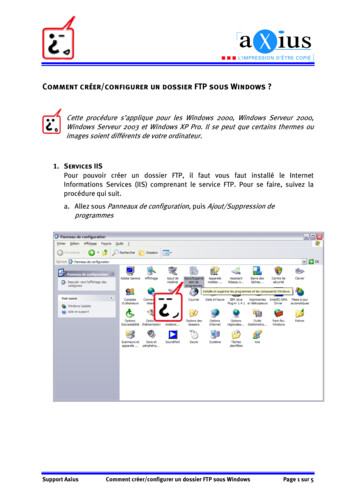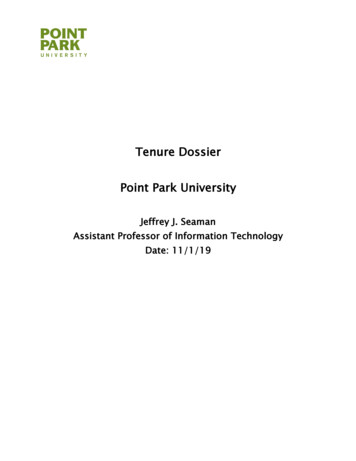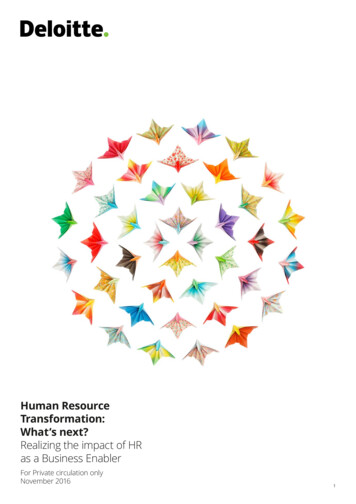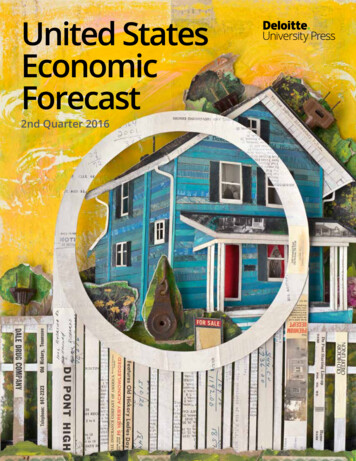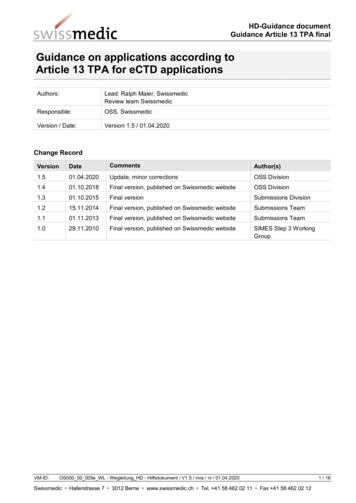
Transcription
The AI DossierBy Deloitte AI Institute
The AI Dossier By Deloitte AI InstituteWhat’s inside01Introduction205Government& Public Services (GPS)4002Consumer4About the Deloitte AI InstituteThe Deloitte AI Institute helps organizations connect all the different dimensions ofthe robust, highly dynamic and rapidly evolving AI ecosystem. The AI Institute leadsconversations on applied AI innovation across industries, with cutting-edge insights,to promote human-machine collaboration in the “Age of With.”Life Sciences& Health Care5203Energy, Resources& Industrials (ER&I)16The Deloitte AI Institute aims to promote the dialogue and development of artificialintelligence, stimulate innovation, and examine challenges to AI implementation andways to address them. The AI Institute collaborates with an ecosystem composed ofacademic research groups, start-ups, entrepreneurs, innovators, mature AI productleaders, and AI visionaries, to explore key areas of artificial intelligence includingrisks, policies, ethics, future of work and talent, and applied AI use cases. Combinedwith Deloitte’s deep knowledge and experience in artificial intelligence applications,the Institute helps make sense of this complex ecosystem, and as a result, deliverimpactful perspectives to help organizations succeed by making informed AI decisions.0607Technology, Media &Telecommunications (TMT)7404Financial Services (FSI)2808Conclusion87No matter what stage of the AI journey you’re in; whether you’re a board member ora C-Suite leader driving strategy for your organization, or a hands on data scientist,bringing an AI strategy to life, the Deloitte AI institute can help you learn more about howenterprises across the world are leveraging AI for a competitive advantage. Visit us at theDeloitte AI Institute for a full body of our work, subscribe to our podcasts and newsletter,and join us at our meet ups and live events. Let’s explore the future of AI together.www.deloitte.com/us/AIInstitute1
The AI Dossier By Deloitte AI InstituteThe AI Dossier By Deloitte AI InstituteIntroductionSix ways that AI creates business valueAfter decades as science fiction fantasy, artificial intelligence (AI) has made the leap to practicalreality and is quickly becoming a competitive necessity. Yet, amidst the current frenzy of AIadvancement and adoption, many leaders and decisionmakers still have significant questionsabout what AI can actually do for their businesses.This dossier highlights dozens of the most compelling, business-ready use cases for AI acrosssix major industries. Each use case features a summary of the key business issues andopportunities, how AI can help, and the benefits that are likely to be achieved. The dossier alsoincludes several emerging AI use cases for each industry that are expected to have a majorimpact in the future.Of course, the best uses for AI vary from one organization to the next, and there manycompelling use cases for AI beyond the ones highlighted here. However, reading through thiscollection should give you a much clearer sense of what AI is capable of achieving in a businesscontext—now, and over the next several years—so you can make smart decisions about when,where, and how to deploy AI within your own organization (and how much time, money, andattention you should be investing in it today).Looking across all AI use cases, there are generally six major ways that AI cancreate value for a business:1Cost reductionApplying AI and intelligentautomation solutions toautomate tasks that are relativelylow value and often repetitive,can reduce costs throughimproved efficiency and quality.ExampleAutomating data entry andpatient appointment schedulingusing natural languageprocessing.TransformedengagementChanging the way peopleinteract with technology,enabling businesses to engagewith people on human termsrather than forcing humans toengage on machine terms.Nitin MittalUS AI Co-LeaderDeloitte Consulting LLP2Irfan SaifUS AI Co-LeaderDeloitte Risk & Financial AdvisoryExampleUsing conversational bots thatcan understand and respond tocustomer sentiment to addresscustomer needs more effectively.Speed to executionReducing the time required toachieve operational and businessresults by minimizing latency.ExampleAccelerating the processof drug approval by usingpredictive insights to createa synthetic trial.Reduced complexityImproving understandingand decision making throughanalytics that are moreproactive, predictive, and ableto see patterns in increasinglycomplex sources.ExampleReducing factory downtimeby predicting machinerymaintenance needs.Fueled innovationFortified trustExampleRecommending new productconcepts and features based oncustomer needs and preferencesmined from social media.ExampleIdentifying and anticipating cyberattacks before they occur.Redefining where to play andhow to win by using AI to enableinnovative new products,markets, and business models.Securing a business fromrisks such as fraud andcyber—improving quality andconsistency while enablinggreater transparency toenhance brand trust.3
The AI Dossier By Deloitte AI InstituteThe AI Dossier By Deloitte AI InstituteFor most organizations, however, the biggestchallenge is moving from concept to scale. Forconsumer-related businesses, this challengecan be particularly difficult since many havelarge legacy data and analytics platforms,decentralized data and analytics operations,and (in many cases) decentralized authorityand responsibility—whether across businessunits, or even more so, across independentlyoperated franchises. This often leads to databeing inconsistent, poor quality, and limitedin usability, which can be a big problem forAI systems, which tend to be extremely dataintensive (with the quality of the input havinga direct impact on the quality of the output).Another common obstacle is achievingalignment and integration across businessand IT stakeholders. Often, AI is used inisolated pockets of the organization—sometimes working with IT, sometimesnot. However, in order to achieve thefull benefits of AI at scale, an integratedbusiness and technology plan (and case forchange) is important.The ConsumerAI DossierThe Consumer industry, as we viewit, encompasses a wide range ofbusinesses including ConsumerProducts, Retail, Automotive, Lodging,Restaurants, Travel, and Transportation. Whatthese seemingly disparate businesses havein common is a strong and defining focus onserving customers—and a common set ofcurrent and future business issues they aresolving for.4Consumer-related businesses are activelyexploring ways to harness the power of AI,and many valuable use cases are emerging.However, AI adoption and maturity levelsvary widely for a variety of reasons, including:scalability due to data quality and complexity;organizational constructs and talent scarcity;and lack of trust.Over time, the task of building trust in AI willlikely get easier as AI technologies becomemore widely accessible—and accepted—for businesses and consumers alike. Everysuccessful AI deployment fuels a virtuouscycle that improves people’s understandingof what AI can do and helps expand thescale and scope of future AI use cases.Also, because these learning algorithmsand solutions reduce the effort it takesto deliver insights and decisive action,the resulting operational improvementstypically increase confidence and driveincreased return on investment.Looking ahead, AI systems for consumerrelated businesses are expected to becomeincreasingly autonomous—changing the waycompanies move goods, enabling increasedmobility, and transforming how they managetheir workforces—while at the same timebecoming increasingly interconnected acrossentire ecosystems, enabling AI to add value tobusiness processes from end to end.Similarly, in many organizations therecontinues to be a lack of trust in AI and what itcan and should be allowed to do. Tackling thisissue should include a coordinated changemanagement approach for communicatingwith leaders and teams and hearing/addressing their concerns. For businesseswithout direct control over this criticalelement, deploying AI at scale can be difficultto achieve.Over time, the task of building trust in AI will likely get easier as AItechnologies become more widely accessible—and accepted—for businesses and consumers alike.5
The AI Dossier By Deloitte AI InstituteThe AI Dossier By Deloitte AI InstituteNext level personalizationMore than fleeting improvements(Fleet Network Optimization)Use AI and machine learning to createoptimized network plans for ground and airfleets—maximizing efficiencies within andacross business lines.Issue/OpportunityInefficient network plans cost companies millionsof dollars every year. Yet, according to theJournal of Commerce, 85 percent of shippersand consignees believe their industry has beensignificantly slower than other industries atimplementing new technologies.2(Connected Customer)How AI can help Optimize fleet utilization and empty repositioning.Companies can use machine learning andpredictive analytics to optimize their fleet utilizationand empty repositioning. Initially, this can be donethrough a human-in-the-loop approach, with AImodels providing recommendations for drivers andplanners to implement. However, as the modelslearn over time, the optimization process can evolveto become more automated and prescriptive. Enable real-time decision-making. AI systems can pullin and process a wide range of data in real time—including information about traffic, weather, roadconditions, and other data-in-motion. This can beused to automate change processes and/or enabledrivers and planners to efficiently make optimaldecisions in the face of unexpected circumstances. Capitalize on IoT. AI-based IoT enables better, moreinformed downtime predictions. Machine learningmodels can use those improved predictions tooptimize fleet usage and operations in real time.Possible benefitsIncreased efficiency and profits.AI can help a company efficiently scale itsoperations within and across its globalground, air, and sea fleets—boostingefficiency and profits.6Personalize and improve the customerexperience through consolidated platformsthat harness the power of AI, machine learning,and natural language processing.Issue/OpportunityAccording to Gartner, customer service and supportis one of the largest segments of CRM, comprising36 percent of the CRM market in 2018.3 Yet, despitethe segment’s size and maturity, companies need tocontinue actively keeping pace with their competitorsin order to provide consistent customer serviceacross multiple levels, maintain customer loyalty,and prepare for disruption from the new digitalbusiness ecosystem. Throughout the customerjourney and lifecycle, it is now possible to personalizethe customer experience across all channels usingmachine learning, conversational AI, and naturallanguage processing.How AI can help Automate customer interactions. Chatbots andvirtual customer assistants have become hot topicsfor organizations looking to redesign and upgradetheir customer service experiences. Use IoT to sense customer sentiment and needs.Consolidated customer service platformsbased on AI and IoT enable customer serviceproviders to sense the sentiments and needs ofconnected customers. Personalize the customer experience. Using machinelearning and data-in-motion, companies canprovide real-time recommendations and decisionsupport that enable a tailored customer experiencebefore, during, and after each interaction—improving customer lifetime value and loyalty.Possible benefitsReduced downtime andmaintenance costs.AI technologies can reduce costs anddowntime related to maintenance.Higher revenue.AI can help improve fleet positioningto better meet demand andmaximize revenue.Increased revenue.Greater awareness of customer needs andwants can drive higher revenue.Better customer experience.Deeper understanding of problempatterns and issues can help companiesimprove the customer experience.Lower costs.AI and machine learning can be used tohandle routine tasks, enabling customerservice centers to operate more efficientlyat reduced cost.7
The AI Dossier By Deloitte AI InstituteThe AI Dossier By Deloitte AI InstituteMix and match(Items Assortment Planning Optimization)Use AI to determine which items should bestocked or substituted to optimize sales,margins, inventory, and customer satisfaction.Issue/OpportunityThe traditional approach to assortment optimizationis costly, slow, prone to human error, and does notmaximize profitability and sustainable growth—relyingon once-a-year manual reviews that cannot keeppace with the rapidly evolving expectations of today’sconsumers. Using AI for assortment optimizationcan help a retailer make better, more sustainabledecisions on how to efficiently provide customers withthe products they need.How AI can help Predict consumer demand and next actions. AIanalytics can predict consumers’ next actionsand their responses to market trends based onpast purchasing behavior. This allows retailers tohave a better understanding of which items areexpected to be in high demand, enabling moreinformed decisions about which items to prioritizefor stocking. Analyze customer data from a wide range ofsources. Neural networks can mine and analyzedata from relevant brands, competitors, and socialmedia and then compare those insights againstthe spending behavior of a retailer’s customers—helping to generate more accurate assortmentforecasts at lower cost. Also, the algorithms canautomatically update their results when the datachanges, enabling retailers to track consumerexpectations in real time.Possible benefitsAssortment planning that is more timely and less costly.By using AI technologies to automate the assortment planningprocess, retailers can analyze consumer expectations in real timewhile avoiding the operational costs of yearly manual reviews.8Closing the loop on supply and demand(Consumer Demand Planning, Forecasting, and Marketing)Use AI to augment marketing and improvedemand planning and forecasting.Issue/OpportunityAs the number of sales channels used by consumerscontinues to grow, retailers should continue toimprove how they plan across multiple saleschannels—and how they handle disruptions. Thistypically requires improved demand-planning andreplenishment capabilities that harness the power ofAI. In the past, marketing solutions could only makedecisions based on a fixed set of assumptions andnarrowly defined inputs and outputs. Although suchsolutions can provide useful insights on a macrolevel, they are often difficult to scale and largely lackthe ability to look at audience specifics. However,thanks to AI, marketers now have the opportunityto analyze consumer mannerisms on a much moredetailed level.How AI can help Understand consumer demand. AI can be usedto understand consumer demand more deeplyby analyzing a wide range of factors suchmacroeconomic elements and competitor activities. Define segments much more precisely. AI allowsmarketers to create hyper-focused, segmentedgroups out of their audiences, generating deeperinsights and increasing the connections betweendata points. Analyze product clusters. AI can examine clusters ofproducts and reveal hidden demand patterns forsimilar and contrasting product groups. Automate decision-making. AI can help automateplanning decisions that involve clear cause-andeffect relationships, allowing planners to focus theirtime and attention on more complex situationswhere causality is less evident.Possible benefitsBetter decisions about what to stock.AI can generate more accurate product recommendations,enabling retailers to make smarter decisions about what to stock.Unprecedented levelsof personalization.AI enables marketers to process andanalyze massive amounts of data and getto know consumers at the individual level.Improved supply chainperformance with fewer stockouts.Machine learning in demand planning andforecasting can help businesses maximizerevenue, improve margins, and optimizeinventory while minimizing occurrencesof products going out of stock due tounanticipated demand.Improved decision-making.AI technologies can help business leadersimprove their decision making—andenable simpler, less important decisions tobe made more quickly.9
The AI Dossier By Deloitte AI InstituteThe AI Dossier By Deloitte AI InstituteCustomer contact in the AI eraEmerging AI use cases in the Consumer industry(Digital Contact Center)Use AI technologies such as natural languageprocessing and machine learning to improvethe contact center experience and overallcustomer satisfaction.Issue/OpportunityInteractions with contact centers can have a hugeimpact on customer satisfaction and loyalty. Yet,because of the pandemic, today’s contact centersface bigger challenges than ever, including higherwork volumes, lower IT budgets, and significantlabor shortages.Contact center automation, which has been steadilyimproving for years, can help address thosechallenges. However, until now, most IVR systemsand chatbots have relied on basic word recognitionand simple file retrieval—and were not sensitive tothe context of a discussion—giving customers a suboptimal experience.A digital contact center that uses AI technologies, suchas natural language processing and machine learning,can be more predictive and sophisticated, significantlyimproving the customer experience while reducingthe need for human involvement.How AI can helpAI technologies such as natural language processingand machine learning enable contact center systemsto be more sophisticated and predictive, significantlyimproving the customer experience while reducingthe need for 24/7 human involvement; allowingcustomer service representatives to focus on morevalue added tasks.The futureof shopping Voice Virtual Assistants. AI-based natural languagetools and machine learning models can be used tobuild Voice Virtual Assistants that deliver a moreefficient, engaging, and human-like customerexperience. These tools can train chatbots toanswer questions, schedule appointments andcalls, and refer customers to the department mostappropriate to handle their requests.Using AI to automate retail outlets,allowing them to operate unattended. Intelligent follow-up. Real-time analytics using AItechnologies can inform contact centers about whento follow up on prior customer interactions. Omnichannel quality management. Using predictiveanalytics and sentiment analysis, all interactionson all digital channels can be monitored, providingvaluable insights about both customers and contactcenter staff. This can give managers real-timeinformation for retraining workers or deciding onthe next best action for customers.(Autonomous Stores)One of the biggest challenges for brick-and-mortar retailersis finding ways to match the cost efficiency of their onlinecompetitors while continuing to differentiate themselves byoffering a local experience that is hands-on and satisfying.With autonomous stores, deep learning software—inconjunction with cameras and sensors—can recognizeeverything that is happening within a store (includingpeople’s movements, expressions, and actions), making itpossible for the store to remain fully stocked and operationalwith little or no human involvement. It can be a near-perfectcombination of full service and self service.Possible benefitsImproved customer satisfactionwith less manual involvement.AI can help boost overall contact centerperformance metrics (including customersatisfaction), while reducing the amount ofmanual intervention required to addresscustomer queries.10Lower costs.Less manual intervention can mean loweroperating costs, since the workforcerequired to support AI-enhanced callcenters can be significantly smaller.More efficient interactions.For some queries, interacting withAI-based bots is more convenient andefficient than working with a human agent,resulting in a better customer experience.11
The AI Dossier By Deloitte AI InstituteThe AI Dossier By Deloitte AI InstituteEmerging AI use cases in the Consumer industryAre we there yet?Fits and smarts(Autonomous Driving)(Fashion Tech)Using AI to operate vehicles autonomously.Using AI to instantly determine which clothing itemsare the best fit for a customer’s particular size andbody shape.For many people, driving is a chore they would ratheravoid. And for many companies, trucking and other drivingrelated activities are just costs of doing business that eatup precious resources and expose the organization tosignificant risk. AI is on the verge of dramatically improvingthe driving experience—with human drivers strictly optional.Autonomous driving combines onboard sensors andlocalization technologies with AI-based decision models thatare designed to reduce human error and make smarter,more informed decisions about steering, braking, andnavigation. The goal is to create driving capabilities thatare safer, cheaper, and more efficient—reducing accidentsand freeing up humans to focus on activities that are morevaluable and satisfying.12Emerging AI use cases in the Consumer industryFinding items that fit is one of the worst parts of clothesshopping. From a consumer’s perspective, it can be atime-consuming hassle during the purchase phase—andall too often leads to dissatisfaction and return hassles aswell. From a retailer’s perspective, it can arguably be aneven bigger problem, requiring large inventories of sizesand styles; sales clerks with sufficient experience andexpertise tend to steer customers toward the right items;unhappy customers; and the time and expense of dealingwith returns. Systems that incorporate machine learning,computer vision, and 3D scanning can help minimize theproblem by obtaining a shopper’s measurements in real timesimply by having them stand in front of a camera. Thosemeasurements can then be matched against a database ofclothing to find the best fit, improving customer satisfactionand reducing the cost of returns.13
The AI Dossier By Deloitte AI InstituteThe AI Dossier By Deloitte AI InstituteEmerging AI use cases in the Consumer industryHealth your way14Emerging AI use cases in the Consumer industry(Personalized Health, Fitness,and Wellness)The paradox ofAI personalizationUsing AI with wearable and non-wearable devices tomonitor people’s health and provide real-time feedbackand coaching.Using AI to transform the customer service experience(and how service is delivered) in many cases allowingcustomers to be served automatically and effortlessly.Imagine a world where every individual’s health andwellness experience could be tailored to that person’sunique needs—in real time—while also benefiting from thecollective knowledge and experience gained from everyoneelse. With machine learning and other AI technologies,systems can be trained over time based on data frommillions of users, enabling data-driven, personalized coachingthat drives behavior change and helps manage and preventchronic diseases. That’s the future of health and wellness,and with the latest advances in AI (and the proliferation ofdevices such as smartwatches) it’s already starting.It’s ironic to think that introducing more machines and AItechnologies into the customer service experience couldactually make it more personal. But that’s exactly what’shappening. By applying AI across the entire customerjourney, customer service experiences, processes, andinteractions are evolving from human-human to humanmachine and ultimately machine-machine, enablingcustomers to be served in ways that are increasinglyconvenient, efficient, and effective—and, paradoxically,increasingly personal, with each individual’s needs beingaddressed automatically and autonomously.(Service Experience Modernization)15
The AI Dossier By Deloitte AI InstituteThe AI Dossier By Deloitte AI InstituteThe main challenges to increased AIadoption and deployment largely revolvesaround data. Unlike many other industrieswhere digital data plays a central role, ER&Istill revolves around physical work andphysical assets—with many of those assetsgeographically scattered and disconnectedfrom digital networks. Widespreaddeployment of IoT-related technologies isstarting to fill this data void. However, inorder to be useful, the resulting data needsto be organized, captured, and analyzed ina timely manner. Also, edge computing andedge AI technologies should be harnessedto enable timely processing and analysis ofdata in dispersed locations at the edge ofthe network.The Energy, Resources& Industrials AI DossierAI adoption and deployment seemto be less extensive and maturein Energy, Resources & Industrials(ER&I) than in most other industries.So far, there have been fewer big AI successstories in ER&I—and thus less competitivepressure to take immediate action. Althoughmost ER&I companies generally acknowledge16the importance of AI—and see it is anessential and disruptive capability that couldgreatly affect their ability to operate andcompete in the future—most efforts to datehave been limited to small-scale pilots andproofs-of-concept focused on narrow partsof the business.For most ER&I companies, the immediateand important next step is to establishan internal team with expertise in AI, datascience, and data engineering to serve asa focal point for all AI-related activities andinvestments. This team would coordinateAI activities across the company’s businessecosystem, while providing a core set ofinternal AI resources and capabilities thatcan be supplemented from the outside asneeded. Also, the team would provide abroad, balanced, and informed perspectiveon using AI across the enterprise.Too many AI initiatives and visions in ER&Iare either overly tactical and technical (toonarrowly focused, and often highlightingtechnical capabilities that are exciting but notvery useful), or overly strategic and ambitious(too difficult and expensive to implement,requiring data and advanced capabilitiesthat don’t currently exist). To succeed with AI,ER&I companies should have strategies androadmaps based on a practical understandingof what parts of the business are best suitedfor AI.One early and ongoing focus area for AI inER&I is making machine maintenance morepredictive and less reactive. Another key focusarea that is getting a lot of traction thesedays is using AI to improve interactions withcustomers and field workers. Also, some ER&Icompanies are starting to explore the use ofAI to help them handle extreme weather andother hard-to-predict events. By harnessingthe power of AI vision and other advancedAI technologies, companies can monitorand analyze vast amounts of information—including data from field sensors, drone video,and weather radar—with a level of timeliness,accuracy, and thoroughness that humansalone simply cannot achieve.Expanding on the idea of machines helpinghumans be more efficient and effective,AI’s single biggest impact in ER&I couldbe helping companies address the futureworkforce gap. The Biden administration’smulti-trillion dollar commitment toinfrastructure is expected to dramaticallyincrease business activity throughout ER&I,but could also create a significant shortage ofworkers and expertise. AI can help addressthis gap by augmenting the work done byhumans—doing much of the preparatoryanalysis and heavy lifting so human workerscan focus on activities that require skills andexpertise that are uniquely human.17
The AI Dossier By Deloitte AI InstituteThe AI Dossier By Deloitte AI InstituteKeeping downtime downAI at the edge(Predictive Machine Maintenance)Use AI to optimize industrial machineperformance, predict failures, and informmaintenance requirements with IoT-poweredasset monitoring.Issue/OpportunityMachine maintenance is typically a significant sourceof cost savings, as the cost of unplanned downtimefor industrial manufacturers is approximately 50billion annually.4 Preventative maintenance forplant assets has traditionally relied on mean-timeto-failure to determine when maintenance shouldbe scheduled (with breakdowns and failures notedin service logs to analyze historical performance).However, with the industrial IoT market growing—and IoT sensors becoming ubiquitous in factories—industrial manufacturers now have a valuableopportunity to use IOT data and AI to make smarterdecisions about when machines should be servicedor replaced, helping factories maximize productionoutput at lower cost.(Edge AI for Production and Planning)How AI can help Better predict and plan for necessary maintenanceand downtime. By monitoring machines andcollecting feedback data in real time, AI technologiescan analyze patterns for each machine todetermine its actual maintenance needs and createa customized schedule that minimizes overalldowntime on the factory floor. Also, as historicaldata is collected and analyzed, AI can help factorymanagers be increasingly proactive in schedulingdowntime for maintenance. Proactively identify and fix hidden quality problems.Over time, AI can learn to recognize patterns inIoT sensor data to identify which machine partsare most likely to fail. These results can be furtheranalyzed to understand the correlation betweencritical parts’ performance and the quality ofproduct output. Armed with these AI-driveninsights, factory managers can be more informedand precise about the parts for which they requestmaintenance, and can even provide feedback tohelp equipment manufacturers improve criticalparts that fail frequently.18Issue/OpportunityThe IoT market is expected to reach 2.4 trillionby 2027,5 with adoption eminent for companies inIoT-heavy ER&I sectors. This breathtaking growthwould enable a sharp increase in the volume andsophistication of data collection and actionableinsights at factory, asset, and industrial endpoints.Higher data volume leads to increased latency, andcan greatly increase the need for processing powerand security at the edge of the network. To handleall
Optimize fleet utilization and empty repositioning. Companies can use machine learning and predictive analytics to optimize their fleet utilization and empty repositioning. Initially, this can be done through a human-in-the-loop approach, with AI models providing recommendations for drivers and planners to implement. However, as the models



